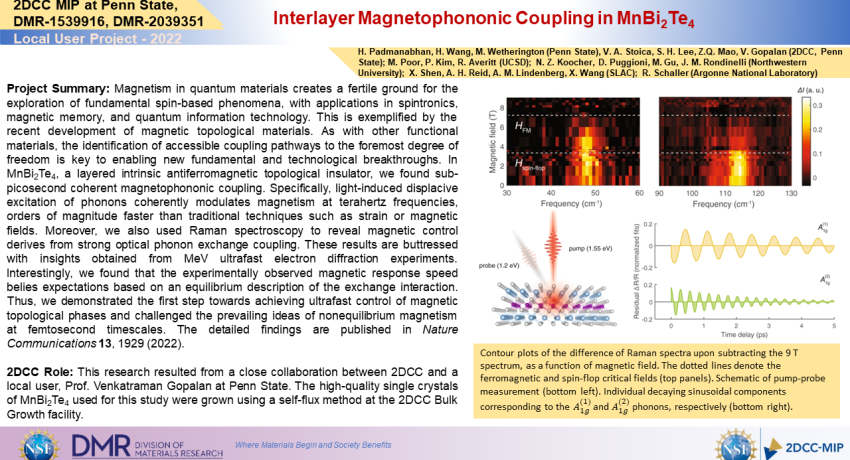Project Summary: Magnetism in quantum materials creates a fertile ground for the exploration of fundamental spin-based phenomena, with applications in spintronics, magnetic memory, and quantum information technology. This is exemplified by the recent development of magnetic topological materials. As with other functional materials, the identification of accessible coupling pathways to the foremost degree of freedom is key to enabling new fundamental and technological breakthroughs. In MnBi2Te4, a layered intrinsic antiferromagnetic topological insulator, we found sub-picosecond coherent magnetophononic coupling. Specifically, light-induced displacive excitation of phonons coherently modulates magnetism at terahertz frequencies, orders of magnitude faster than traditional techniques such as strain or magnetic fields. Moreover, we also used Raman spectroscopy to reveal magnetic control derives from strong optical phonon exchange coupling. These results are buttressed with insights obtained from MeV ultrafast electron diffraction experiments. Interestingly, we found that the experimentally observed magnetic response speed belies expectations based on an equilibrium description of the exchange interaction. Thus, we demonstrated the first step towards achieving ultrafast control of magnetic topological phases and challenged the prevailing ideas of nonequilibrium magnetism at femtosecond timescales. The detailed findings are published in Nature Communications 13, 1929 (2022).
2DCC Role: This research resulted from a close collaboration between 2DCC and a local user, Prof. Venkatraman Gopalan at Penn State. The high-quality single crystals of MnBi2Te4 used for this study were grown using a self-flux method at the 2DCC Bulk Growth facility.
What Has Been Achieved: This works demonstrates interlayer magnetophononic coupling in the layered magnetic topological insulator MnBi2Te4
Importance of the Achievement: The results resulting from this work demonstrates a pathway toward achieving ultrafast light-induced topological phase transitions.
Unique Feature(s) of the MIP that Enabled this Achievement: Synthesis of high-quality MnBi2Te4 single crystals are extremely challenging due to the disorders caused by its non-stoichiometry compositions. The 2DCC has developed a protocol to grow MnBi2Te4 single crystals with good quality. The close collaboration between the user and the 2DCC bulk synthesis team enables this work.
(If Applicable) Publication:
Hari Padmanabhan, Maxwell Poore, Peter Kim, Nathan Z. Koocher, Vladimir A. Stoica, Danilo Puggioni, Huaiyu Wang, Xiaozhe Shen, Alexander H. Reid, Mingqiang Gu, Maxwell Wetherington, Seng Huat Lee, Richard Schaller, Zhiqiang Mao, Aaron M. Lindenberg, Xijie Wang, James M. Rondinelli, Richard Averitt, Venkatraman Gopalan, Nature Communications 13, 1929 (2022). DOI: 10.1038/s41467-022-29545-5
Acknowledgements: H.P., V.A.S., H.W., P.K., M.P., N.Z.K., A.M.L., R.A., J.M.R., and V.G. acknowledge support from the DOE-BES grant DE-SC0012375. H.P. acknowledges partial support from the DOE Computational Materials program, DE-SC0020145. Support for crystal growth and characterization was provided by the National Science Foundation through the Penn State 2D Crystal Consortium-Materials Innovation Platform (2DCC-MIP) under NSF cooperative agreement DMR-1539916 and DMR-2039351. D.P. was supported by the Army Research Office (ARO) under grant no. W911NF-15-1-0017. SLAC MeV-UED is supported in part by the DOE-BES SUF Division Accelerator & Detector R&D program, the LCLS Facility, and SLAC under Contract Nos. DE-AC02–05-CH11231 and DE-AC02–76SF00515. Use of the Center for Nanoscale Materials, a DOE Office of Science User Facility, was supported by the U.S. Department of Energy, Office of Science, Office of Basic Energy Sciences, under Contract No. DE-AC02-06CH11357. Zero-field Raman measurements were performed in the Materials Characterization Laboratory within the Materials Research Institute at Penn State.
